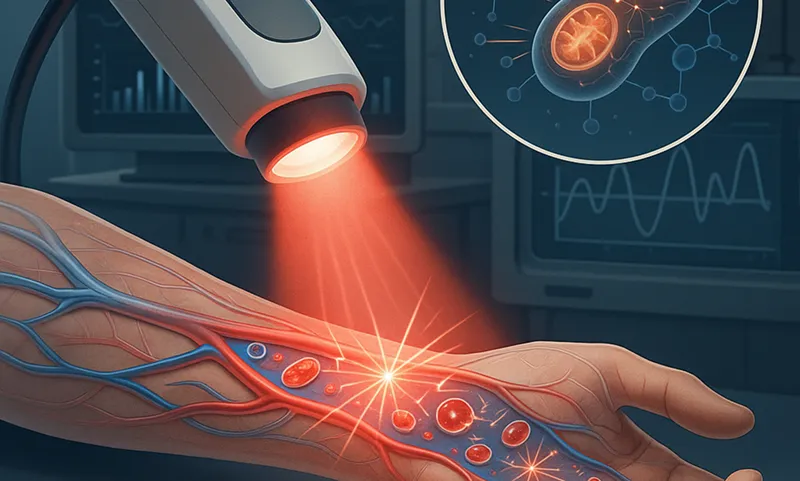
Emerging Therapeutic Technologies

Photobiomodulation and Blood Irradiation: A Critical Analysis of Emerging Therapeutic Technologies
An independent healthcare observer's examination of the clinical evidence, opportunities, and challenges surrounding advanced photobiomodulation systems
Introduction: Light as Medicine in the Modern Era
The intersection of light and medicine has captured scientific attention for over a century, yet recent technological advances have brought photobiomodulation therapy—particularly intravenous blood irradiation—back into clinical focus. As healthcare systems worldwide grapple with antibiotic resistance, chronic disease management, and the limitations of conventional treatments, technologies like the Hemealumen TS polychromatic system represent a fascinating convergence of historical medical practices and cutting-edge engineering.
This analysis examines the current state of photobiomodulation technology, its clinical evidence base, and the broader implications for patients suffering from various conditions. Rather than advocating for or against these technologies, we aim to provide healthcare professionals and patients with an objective assessment of what the evidence reveals—and what questions remain unanswered.
The Technology Landscape: Evolution from Historical Roots
Historical Foundation and Modern Innovation
Blood irradiation therapy traces its origins to the 1920s when Emmett Knott first developed ultraviolet blood irradiation (UVBI) techniques. Historical records indicate remarkable success rates, with over 6,500 patients treated by 1942 achieving greater than 95% success rates across various infectious diseases without reported adverse effects. However, the advent of antibiotics in the 1940s led to the decline of these approaches in Western medicine, earning UVBI the moniker "the cure that time forgot."
The modern resurgence centers on technological sophistication. Contemporary systems like the Hemealumen TS represent what manufacturers claim is "the first major advancement in UVBI technology in 100 years." The device features a patented TRIVETTE™ triple quartz tube design that reportedly increases blood exposure time by 600% compared to traditional single-tube systems, combined with six distinct wavelengths ranging from UVC (253.7nm) to red light (675nm).
Mechanistic Understanding: Promise and Complexity
The proposed mechanisms of action span multiple biological systems:
Cellular Level Effects:
Direct pathogen DNA/RNA damage through UV wavelengths
Enhanced mitochondrial ATP synthesis via cytochrome c oxidase activation
Modulation of inflammatory cytokines and immune cell function
Improved blood rheological properties and microcirculation
Systemic Responses:
Activation of phagocytic cells and immune system components
Enhanced oxygen utilization and delivery
Modulation of oxidative stress pathways
Potential dismantling of pathogen-associated proteins like nagalase
However, as recent scientific reviews acknowledge, "the exact cascade of events and the primary cellular targets are still under debate." This mechanistic uncertainty represents both an opportunity for further research and a challenge for clinical standardization.
Clinical Evidence: Examining the Data Landscape
Infectious Disease Applications: Compelling but Limited
The most striking claims surrounding advanced photobiomodulation systems relate to infectious disease treatment. Research data suggests remarkable outcomes:
Viral Infections:
Hepatitis C: FDA Phase II trial showed 44.9% peak viral load reduction (p=0.0048)
COVID-19: Reported 7-day hospital stay reduction with zero mortality in treated populations
Dengue/Zika: Complete resolution within 48 hours in Costa Rica studies
Bacterial and Parasitic Infections:
Tuberculosis: Historical data showing 100% disease-free rates versus 58.8% in controls
Malaria: 55/55 cases reportedly resolved within 2 days in African studies
MRSA and antibiotic-resistant strains: No reported resistance development
These results, if reproducible, would represent transformative advances in infectious disease management. However, several critical considerations emerge from independent analysis:
Study Limitations: Current photobiomodulation research faces significant methodological challenges. A recent meta-analysis examining polychromatic light therapy noted that "all studies were deemed to have a high risk of bias," with sample sizes often insufficient for reliable conclusions. For instance, studies examining photobiomodulation in age-related macular degeneration included only 247 eyes across three trials, far below the required information size of 555 eyes for reliable statistical power.
Clinical Significance Versus Statistical Significance: Even when studies demonstrate statistically significant improvements, these may not translate to clinically meaningful benefits. The concept of Minimal Clinically Important Difference (MCID) reveals that some statistically significant results fail to meet thresholds for practical patient benefit.
Autoimmune and Chronic Conditions: Mixed Evidence
Research suggests potential benefits for autoimmune conditions:
Rheumatoid arthritis: 70-92% improvement rates reported
Asthma: Significant improvement in steroid-resistant cases
Multiple sclerosis: 14/26 patients showed good clinical response
However, the evidence base remains heterogeneous, with varied treatment parameters and limited long-term follow-up data. The lack of standardized protocols across studies makes direct comparisons challenging and limits the ability to establish optimal treatment regimens.
Cardiovascular Applications: Established Mechanisms
Cardiovascular applications show perhaps the most consistent evidence base, with documented improvements in:
Blood rheological properties and microcirculation
Peripheral arterial disease outcomes (3x walking distance improvement)
Thrombophlebitis resolution (24-48 hour clot resolution)
These effects align with well-understood mechanisms of photobiomodulation on blood components and vascular function, providing a more solid foundation for clinical application.
Patient Impact Analysis: Opportunities and Considerations
Potential Benefits for Underserved Populations
For patients with limited treatment options, advanced photobiomodulation systems may offer significant advantages:
Antibiotic-Resistant Infections: With rising antibiotic resistance representing a global health crisis, technologies that demonstrate efficacy against resistant pathogens without inducing further resistance could prove invaluable. The reported absence of pathogen resistance development to UV irradiation suggests a fundamental advantage over chemical antimicrobials.
Chronic Complex Conditions: Patients with multiple comorbidities or those who have failed conventional treatments may benefit from the systemic, multi-pathway effects of photobiomodulation therapy. The reported safety profile, with over 80 years of clinical use without significant adverse effects, presents an attractive risk-benefit ratio.
Immunocompromised Patients: The immune-modulating effects of photobiomodulation may provide particular benefits for patients with compromised immune systems, though careful monitoring would be essential.
Limitations and Realistic Expectations
Treatment Accessibility: Advanced photobiomodulation systems represent significant capital investments, potentially limiting access to specialized centers. The Hemealumen TS and similar devices require substantial financial commitment and specialized training, potentially creating disparities in access.
Protocol Standardization: The lack of standardized treatment protocols presents challenges for both practitioners and patients. Without clear guidelines for optimal wavelengths, exposure times, and treatment frequencies, outcomes may vary significantly between providers.
Long-term Efficacy Questions: While short-term results appear promising, comprehensive long-term efficacy and safety data remain limited. Patients considering these treatments should understand that long-term outcomes are still being evaluated.
Healthcare System Integration: Challenges and Opportunities
Regulatory Landscape
The regulatory environment for photobiomodulation devices presents both opportunities and challenges:
FDA Status: While original Knott UVBI technology was "grandfathered" by the FDA in the 1940s, modern devices require 510(k) clearance as Class II medical devices. This regulatory framework provides safety oversight while allowing innovation within established parameters.
International Variations: Different regulatory approaches globally create varying access patterns. Continued research in Russia and Germany, combined with growing interest in emerging infectious disease preparedness, suggests potential for expanded international adoption.
Economic Considerations
Healthcare Cost Impact: If clinical claims prove accurate, photobiomodulation therapy could significantly reduce healthcare costs through:
Reduced hospital stays for infectious diseases
Decreased antibiotic usage and associated resistance costs
Improved outcomes in chronic disease management
Implementation Costs: However, initial implementation requires substantial investment in equipment, training, and protocol development. Healthcare systems must weigh these upfront costs against potential long-term savings.
Professional Adoption Patterns
Current adoption appears concentrated in integrative and functional medicine practices, with growing interest from conventional healthcare providers. Professional testimonials suggest enthusiasm among early adopters, though broader medical community acceptance requires more robust evidence.
Critical Assessment: Balancing Promise and Prudence
Strengths of the Evidence Base
Historical Safety Record: Over 80 years of clinical use with minimal reported adverse effects provides reassurance about basic safety
Mechanistic Plausibility: Proposed mechanisms align with established photobiomodulation principles
Diverse Applications: Evidence spans multiple medical specialties and conditions
Resistance Profile: No reported pathogen resistance development offers advantages over conventional antimicrobials
Areas Requiring Caution
Study Quality: High risk of bias in many studies limits confidence in reported outcomes
Sample Sizes: Many studies involve small patient populations insufficient for definitive conclusions
Standardization Gaps: Varied treatment parameters across studies complicate interpretation
Long-term Data: Limited information on sustained benefits and potential long-term effects
The Need for Rigorous Research
Independent scientific reviews consistently emphasize the need for "larger randomized controlled trials" with rigorous methodology. The current evidence base, while promising, requires substantial strengthening through:
Well-designed, adequately powered clinical trials
Standardized treatment protocols
Long-term follow-up studies
Comprehensive safety monitoring
Future Directions: Research and Clinical Priorities
Research Imperatives
Mechanism Elucidation: Further research into the precise cellular and molecular pathways activated by different wavelengths and treatment parameters could optimize therapeutic protocols and predict outcomes more reliably.
Comparative Effectiveness: Head-to-head comparisons with standard treatments across various conditions would provide crucial data for clinical decision-making.
Personalization Strategies: Investigation into patient-specific factors that predict treatment response could enable more targeted therapeutic approaches.
Clinical Integration Pathways
Training and Certification: Development of standardized training programs and certification processes could ensure consistent, safe application across healthcare settings.
Protocol Development: Evidence-based treatment protocols for specific conditions would facilitate broader adoption and improve outcomes consistency.
Outcome Monitoring: Systematic collection of real-world outcomes data could provide valuable insights into effectiveness across diverse patient populations.
Implications for Patients and Providers
For Patients Considering Treatment
Patients evaluating photobiomodulation therapy should consider:
Potential Benefits:
Non-invasive treatment option with favorable safety profile
Possible effectiveness for conditions with limited conventional options
Systemic effects that may address multiple health issues simultaneously
Important Considerations:
Limited long-term outcome data
Significant cost and potential insurance coverage limitations
Need for multiple treatment sessions
Importance of selecting experienced, qualified providers
For Healthcare Providers
Clinicians considering incorporating photobiomodulation therapy should evaluate:
Clinical Applications:
Most promising evidence in cardiovascular and infectious disease applications
Potential value for patients with antibiotic-resistant infections
Possible benefits for complex chronic conditions
Implementation Requirements:
Substantial capital investment and training requirements
Need for comprehensive patient evaluation and monitoring protocols
Importance of realistic outcome expectations and patient education
Conclusion: Navigating Promise and Uncertainty
Photobiomodulation technology, exemplified by advanced systems like the Hemealumen TS, represents a fascinating intersection of historical medical wisdom and modern technological innovation. The clinical evidence, while promising in many areas, remains incomplete and requires careful interpretation.
For patients suffering from conditions with limited treatment options—particularly antibiotic-resistant infections, complex chronic diseases, and certain autoimmune conditions—these technologies may offer valuable therapeutic alternatives. The favorable safety profile, supported by decades of clinical use, provides reassurance about basic treatment safety.
However, the current evidence base demands cautious optimism rather than uncritical enthusiasm. The need for larger, well-designed clinical trials remains paramount. Healthcare providers and patients must navigate between the promise of innovative therapy and the prudence required when evidence remains evolving.
The future of photobiomodulation therapy likely depends on continued rigorous research, standardization of protocols, and careful documentation of real-world outcomes. As this field continues to develop, maintaining scientific rigor while remaining open to therapeutic innovation will be essential for realizing the potential benefits while protecting patient welfare.
Ultimately, photobiomodulation technology represents neither a panacea nor a false promise, but rather an evolving therapeutic modality that requires continued scientific scrutiny, clinical wisdom, and patient-centered decision-making. The coming years will likely provide clearer answers about its place in modern medicine and its potential to improve outcomes for patients facing challenging health conditions.
This analysis is based on available research and clinical data as of July 2025. Healthcare decisions should always be made in consultation with qualified medical professionals who can assess individual patient circumstances and provide personalized recommendations.
Sources and References:
Hemealumen TS clinical research data and FDA trial results
PubMed systematic reviews on photobiomodulation therapy limitations
Scientific literature on intravenous blood irradiation therapy
Historical UVBI clinical evidence and safety data
Contemporary photobiomodulation mechanism studies


